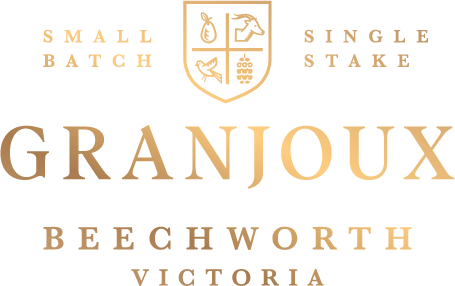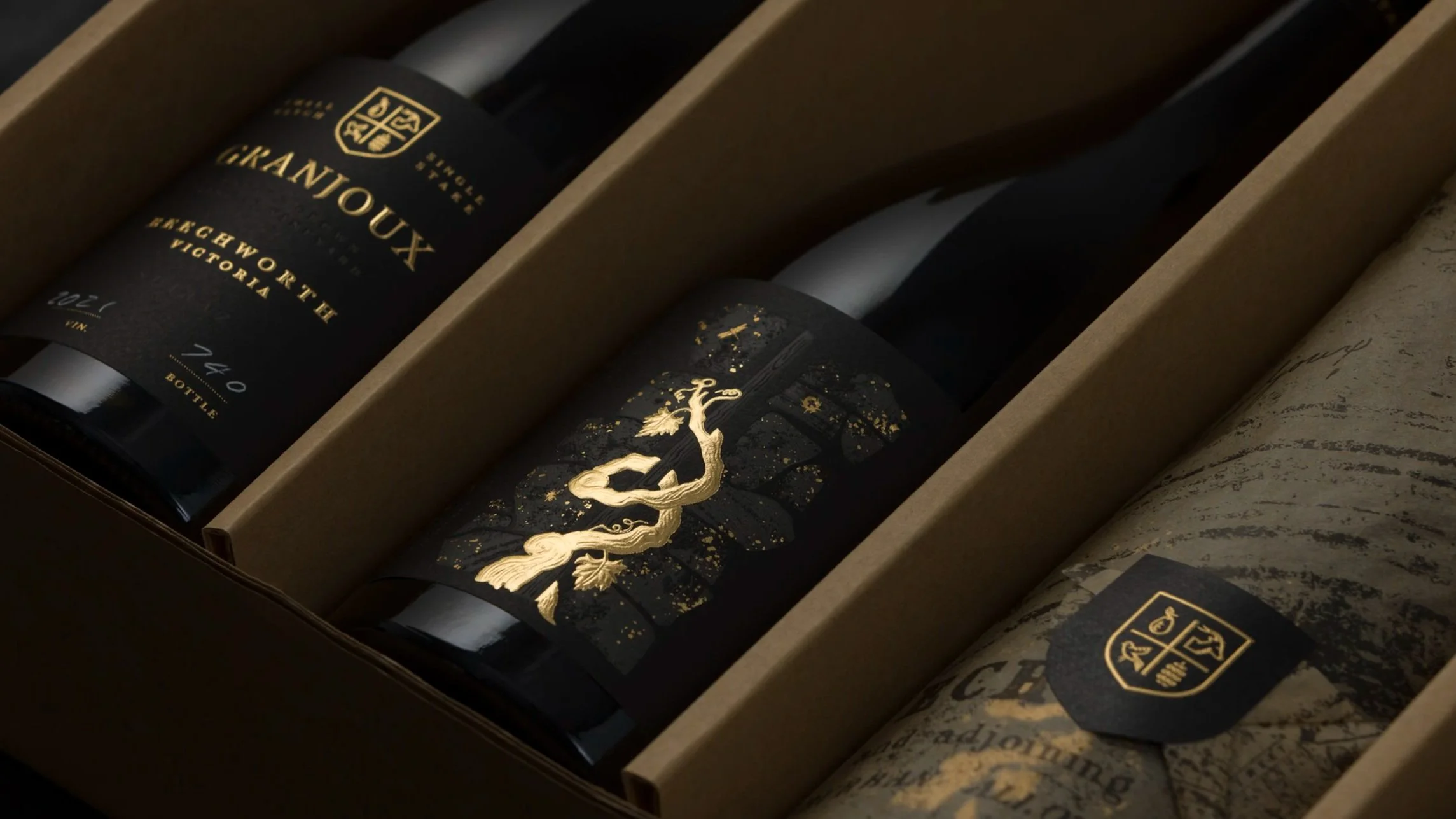Granjoux Chardonnay: The emergence of a Beechworth classic
It has been a particular pleasure to watch the evolution of our Chardonnay, a wine that, in only three vintages, has established itself as a distinctive and promising expression of Australian Chardonnay.
From the tiny, close-planted, 1.1-hectare vineyard overlooking the Gorge in Beechworth, owner Peter Bartholomew, with the help of viticulturist Mark Walpole, have coaxed the young vines into a series of wines that speak with admirable clarity of place and purpose. We recently shared all three vintages (2021, 2022, and 2023) with Jancis Robinson, where she has penned the below for each.
2021 – A restrained debut
The 2021 vintage marked the debut from this exceptionally close-planted site – only 1.1 hectares, with single-staked vines echoing the original plantings for this historic vineyard circa 1860s. For our first release, it was a revelation: complex, richly textured, and astonishingly long, combining Australian brightness with European finesse. There is a luminous purity in this wine, we have been able to create a sense of intention from the very first vintage.
“A second chance to look at this debut vintage from this tiny, exceptionally close-planted, staked vineyard on a site first planted by Frenchman Ambrose Granjoux in the early 1860s. The passion project of restaurateur Peter Bartholomew and Donna Pelka, advised by viticulturist Mark Walpole. 16 months on from this tasting. 2021 was an early vintage producing restrained wines.
Limpid, delicate wine with a strong citrus – lime? – note that has developed a little since June 2024 but is clearly a slow burner. And, as I noted then, it most unusually builds towards the finish, as the best burgundies do. I’d decant this wine to aerate it before serving.”
17+/20. See the full review here.
Also on the 2021 Chardonnay, Max Allen (who writes for Jancis for Australian wines) also shared his views:
“From a small, 1.1-hectare walled vineyard of close-planted (1.5 x 0.91 m), single-stake vines planted in 2017 on the site of a historic 19th-century vineyard. First commercial release.
Fine, restrained, chalky lemon-puff aromas, good, lean and savoury on the tongue, with a sense of richness and length, but a little closed right now. Will open well over the next few years.”
17+/20.
2022 – The vineyard finds its voice
The 2022 vintage was where everything seemed to come into sharper focus. From the same minuscule, close-planted vineyard, the second release impressed Jancis enormously for its purity and confidence, earning 17.5/20 – equal to that of the 2022 Estate Vineyard Chardonnay, from the formidable producer Giaconda. The year was cool and damp, yet the resulting wine has a remarkably frank, transparent flavour, suggesting both energy and distinction. Jancis wrote the below:
“From this increasingly celebrated, tiny, close-planted hillside site planted in 2017 by Peter Bartholomew and Mark Walpole. I’m having to guess at the alcohol because it’s written in such small, faint print on black! 2022 was cool and damp.
Very frank, pure flavour and rather/even more distinction on the palate than the debut vintage of 2021. There is real purity here but also a suggestion of a terroir effect – some stony quality overlaid with notable tension and a certain saline quality. Very distinctive and confident. Sappy and savoury.”
17.5/20. See the full review here.
We think that it’s a wine that captures what makes Beechworth so fascinating: Chardonnay that manages to be both sappy and savoury, bright and serious, expressive yet understated. The 2022 has a crystalline quality that sets it apart – a very distinctive and confident wine, to be enjoyed now or cellared well into the next decade.
2023 – Youthful and promising
At this early stage, the 2023 strikes most as more overtly fresh, and dare we say it “Australian” in character than its other two vintages. There is a tug-of-war between saline and citrus elements on the palate – a lively, insistent, and very youthful still. We know the the wine will settle into something quite captivating. Jancis agrees, and wrote the below:
“…Spontaneous fermentation accordingly took place in a mix of one new 300-litre hogshead and a seasoned 500-litre puncheon. Malolactic conversion was intentionally blocked. After 12 months in barrel, the new-oak component was stirred and transferred to a third-use hogshead, where the entire wine remained on lees for a further four months. The total élevage was 16 months, all in oak.
Somehow the nose seems a little more conventionally Australian than that of the 2022 and 2021 – perhaps because some oak influence is still present? Saline and citrus notes are fighting it out on the palate. It’s still very youthful and may well settle down to bedazzle us. But of the 2021, 2022 and 2023 vintages owner Peter Bartholomew has sent me to taste, the 2022 seems the most complex and satisfying for current drinking.”
16++/20. See the full review here.
A microcosm of modern Beechworth
Taken together, these three vintages trace an extraordinary trajectory. The 2021 laid the foundations, the 2022 captured a voice of purity and poise, and the 2023 shows both resilience and latent brilliance.
What fascinates us most about our Chardonnay is how clearly it reflects our site. This is a wine of tension and saline energy, but also of quiet confidence – a Beechworth Chardonnay that manages to be recognisably Australian without sacrificing its European sensibility.
In a region already famed for its individuality, we’ve tried to share wines not with grandeur or weight, but with precision, restraint, and a certain intellectual charm. For such a young vineyard, we’re very proud of where we’re sitting at this point…quite the achievement!

